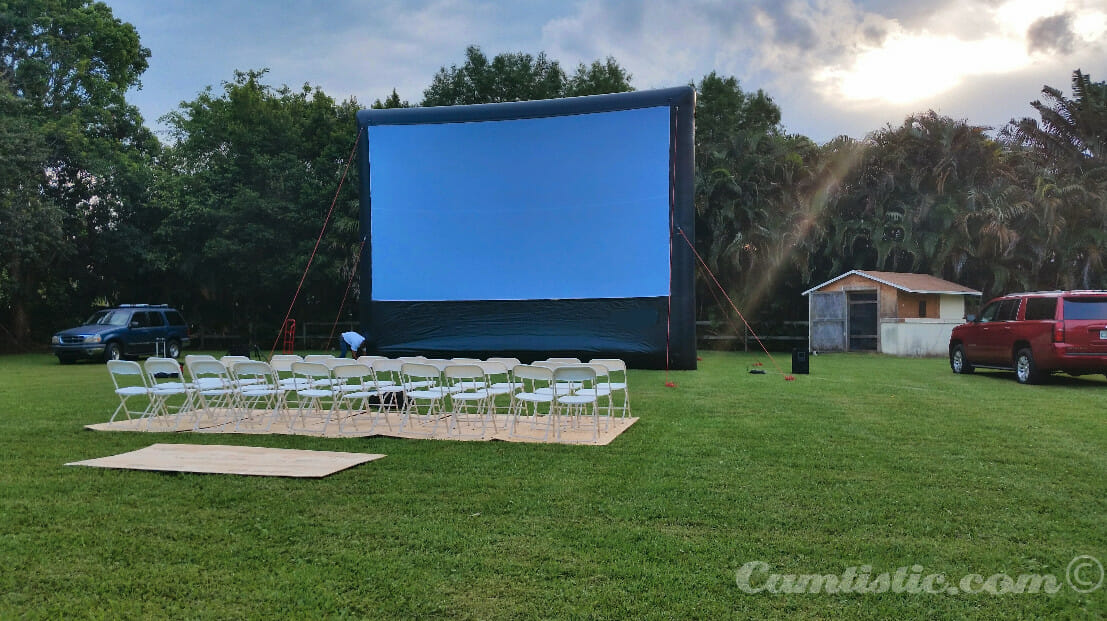This post was most recently updated on December 26th, 2020
With the overwhelming numbers of movie, computer, gaming and media projectors on the market today, what type of projector will be the perfect fit for your home theater, or your next outdoor movie event?
Here are a few things you may want to consider, and some guidelines for choosing the best LCD and DLP projectors. Bare in mind, both types of projector technology perform wonderfully in many types of venues both indoor and outdoors, however, these projectors differ in their internal design and technology.
Perhaps you’re trying to choose between an LCD projector vs a DLP projector. Lets take a look at the two types of projectors and you can decide which of the two will be a fit for your indoor or outdoor movie theater.
What is an LCD projector
What is an LCD projector ?? . The LCD projector is a type of projector that uses liquid crystal displays. A white beam of light is projected behind liquid crystals. These liquid crystal displays are usually made available via a chip whereby the thousands of pixels are woven and twisted into thin panels. Depending on how much electricity is conducted behind these crystals in combination with the beam of light emitted, three main colors are then combined to form millions of color combinations that are ultimately what you see projected on the screen.
![]()
LCD technology has been popular with many devices we’ve been using the past decade, most notably computer monitors, laptops, and flat-screen televisions. LCD’s took off because unlike many of the analog systems that were used at the time were not able to preserve picture quality after continued use.
This was especially the case when applied to home videos, and amateur recordings. With old films and analog videotape, the longer it was used, the more the quality degraded over time. If you were to copy this media, the loss in quality would be copied as well. LCD technology was at the forefront of digital imaging being able to preserve picture quality with little degradation.
Advantages of the LCD Projector and Why We Like Them
For most of our outdoor movie events, we tend to favor the LCD projectors. The LCD projectors in our projector line are workhorses. Reliable, dependable, even after many hours of constant usage .
Yes, some of the parts of have to be replaced and serviced, and there still has to be a lot of care taken from dust, debris and weather elements, but overall, after the maintenance and replacement, the LCD projector retains a lot of the picture quality with less cost involved as compared to the DLP projectors.

One of the other true strengths of the LCD projectors we use are in their versatility, particularly with regard to larger outdoor movie screens. The LCD projectors can be used with the tiniest screens for both indoor and outdoor venues. This very same LCD projector could be used with really large movie screens as well . Some of these huge screens can be as high as 30ft and higher.
So you could really just have one projector for 2 or more different size movie screens. Screens that would be dramatically different in size. Now the other type of projector(DLP projectors) can certainly project amazing image quality with really wonderful contrast. Perhaps better at times than LCD projectors(we’ve already alluded to that in some DLP projector reviews) but LCD’s projector can also deliver this contrast and do it better as the screen gets larger.
This again comes back to the LCD projectors greatest strength, its versatility.
LCD projectors also tend to operate at lower power levels. I’ve noticed the DLP projectors we use run far hotter, especially during the warm months, and many times my DLP projectors will shutdown if not properly ventilated.
Processing Low Resolution Video and Photos
There’s certainly a difference in how data is processed by the LCD vs the DLP projectors. This noticeable difference though is much more apparent when the overall resolution of the video or image is of lower quality. For example, if you’re playing your favorite DVD or Blue-Ray movie, picture quality will be outstanding on both projectors.
This is what you’d expect from professionally produced media. Even when viewing the LCD that doesn’t have native HDMI output, it would be very difficult to notice the loss in overall picture quality if compared to a DLP projector at the very same low resolution.
Now suppose you’re putting together a home video to play for a presentation, slideshows for family and friends. You scan old photos that are not sharp, and the overall resolution of the entire video after completion is not nearly as high or close to professional quality. In this scenario, the LCD may do a slightly better job at handling the lower resolution than the DLP projector.
All the benefits of high contrast, one of the strengths of most DLP projectors is a bit lost. Moreover, over time, as both projectors age with use, the LCD will continue to outperform in projecting lower quality videos and pictures. If cost and savings is an important criteria, then more than likely you’ll be paying more for the DLP projector vs the LCD. Most manufacturers will list how long you can expect the projector to be used before say a lamp has to be replaced.
Some LCD Cons and Disadvantages

There aren’t many, but like everything else, there are some downsides with preferring the LCD projector.. As we’ve written about in our other articles, there will be many situations where a normal throw projector will not work due to the lack of space/area between the screen and projector. When choosing to go with a short throw or ultra-short throw projector, you’ll typically find that the majority of these projectors will be DLP projectors and not LCD projectors.
This doesn’t mean there aren’t any great quality LCD projectors that can short throw. Check out the Epson EMP535 if you really have a preference for LCD projectors and need to project in tight spaces. Nevertheless, if short throw projecting is an absolute must with your movie setups, and if the screen you’ll be using is for a home theater or a relatively small outdoor movie screen, then choosing a DLP projector would be a better choice.
Over time and many hours of normal usage LCD projectors can lose some of the coloration. Newer LCD projectors with advanced paneling do a better job with pixelation over time, but like your LCD TV at home, you can pretty much expect that after a few years, you’ll see a more noticeable difference in the picture quality, even if you were to replace the lamp.
This should not discourage anyone, even an later model LCD projector if properly setup under dark conditions will give amazing picture quality.
What is a DLP Projector
DLP projectors or Digital Light Processing projectors are projectors that apply an array of microscopic mirrors on a single semiconductor chip, called a DMD(Digital Micro mirror Device). Light passes through these millions of mirrors that spin on a wheel which in turn produces the wonderful imagery we’ve all come to know.
Advantages of the DLP Projector
This scaled down single chip design gives the DLP projector some advantages over the LCD projector. Unlike LCD projection technology, where several panels are involved, DLP projectors have all the mirrors contained on one chip, where the imagery is processed in a single contained location.
This is advantageous with regards to overall maintenance . Most DLP projectors seal this area of the projector so that it becomes less prone to collect dust and debris that cause poor image quality. Our favorite gaming projectors are usually the DLP projectors. Be sure to check out the gaming projectors we’ve reviewed and recommended. [topproducts id=”357″ type=”slider”]
DLP projectors in a nutshell – Options and Selection
As we’ve touched on earlier, the biggest advantage of choosing to go with the DLP projector is that you’ll just have a wider selection of projectors to choose from in the retail projector market. Whether it’s a normal throw, short throw, or ultra short throw projector, if the DLP projector is what you had in mind, you will not be limited by the selection. If you will be setting up a home movie theater, especially if the space in your home theater is small and limited to short throw distance, you can expect that the DLP projector will be one of your primary choices.
Some DLP Cons and Disadvantages
Like the LCD projectors and along the same lines, there are a few weak points. The DLP projector may not be your first choice as an outdoor movie projector especially with large screens. As compared with most LCD projectors, the DLP projectors typically aren’t as energy efficient. If leaving the projector on for very long periods of time, this is something you should probably be more mindful of. Always be sure the projector is in well ventilated areas, where the cooling fan can function properly.
Conclusion
To wrap things up. You really can’t go wrong with either technology. It’s like comparing a windows machine vs a mac. Everyone has their preferences, everyone has different applications and tasks they need completed and choosing between the two different computers is just a matter of which type offers the best features and functionality.
There’s really nothing wrong with having both. Even if you’re not a professional and in the business of using projectors, there will be situations where one type of projector is a better choice than the other. You may need a short throw projector for gaming for instance, where in most cases the DLP projector is the the best type of projector for the job, then another time you’ll be outdoors showing videos during a wedding on a larger screen and the LCD will work better.
As we’ve touched on in previous reviews and articles, the best thing to do is ask yourself where you’ll most likely use the projector(LCD or DLP) what type and size screen you are using, and approximately how large/small do you expect your audience to be.


